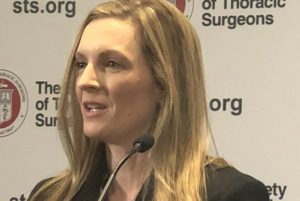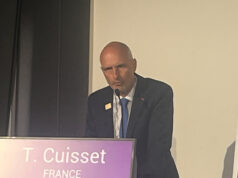
Open heart surgery remains the best option for young and middle-aged adults with aortic valve disease, for now; However, the use of transcatheter aortic valve implantation (TAVI) is continuing to expand to a wider group of eligible patients, according to a presentation at the 56th Annual Meeting of The Society of Thoracic Surgeons (STS 2020; 25–28 January, New Orleans, USA).
Cardiac surgeon and researcher Jennifer S Nelson (Nemours Children’s Hospital, Orlando, USA) said: “Our research favours the use of surgical aortic valve replacement (SAVR) in adults who are younger than 55 years old. Although young and middle-aged adult TAVI candidates do exist, thoughtful patient selection is critical to optimising triage to SAVR and TAVI.”
At a press conference, Nelson explained: “Aortic valve replacement is a commonly performed operation among young and middle-aged adults, but within this group there is a growing population of adults living with congenital heart disease, and they often require repeat valve operations during their lifetime. But, in the context of recent guideline modifications and expanded indications for transcatheter valves, the landscape of aortic valve replacement in adults is shifting. Given these developments, it is important to understand clinical outcomes by valve type in the young and middle aged adult population, as current practice patterns and early outcomes within these groups are unknown.”
Therefore, the aim of the study was to describe contemporary valve utilisation and early outcomes by valve type among young and middle-aged adults (<55 years) undergoing aortic valve replacement, including a subgroup with congenital heart disease. Using the STS National Database, Nelson and colleagues from Nemours and the Cleveland Clinic in Ohio examined data from patients aged 18–54 who received aortic valve replacement or implantation (SAVR or TAVI) between 2013 and 2018. Approximately one-sixth of these patients had congenital heart disease (CHD). As a result, researchers combined data from two components of the Database: the STS Adult Cardiac Surgery Database (ACSD) and the STS Congenital Heart Surgery Database (CHSD). The outcomes were 30-day mortality and a composite measure of morbidity that included renal failure, persistent neurological deficit, reoperation for any reason, and readmission within 30 days.
Overall, 1,580 unique CHSD and 44,173 ACSD operations were analysed, and more than 15% of the operations were related to CHD.
“When the congenital and non-congenital groups were compared, several important differences emerged. Most notably, the congenital patients were younger [43 years vs. 48 years for non-CHD], which was not too surprising, but they also had a significantly higher rate of prior sternotomy [30% CHD vs. 15% non-CHD], and they had more frequently undergone prior aortic valve replacement [12% CHD vs. 10% non-CHD] or repair [10% CHD vs. 2% non-CHD].”
Valve use over time was analysed and showed that bioprosthetic valve use increased, while mechanical valve use remained relatively stable; during the same time period, TAVI utilisation also increased [167%].
The overall mortality rate for the entire cohort was 3.6%. A comparison of mortality by valve type determined that bioprosthetic SAVR and TAVI had similar rates of mortality (3.7% and 3.8%, respectively). Homograft was associated with the highest rate at 9.6%, with pulmonary autografts (Ross operation) having the lowest rate at 0.7%.
When all aortic valve replacements were compared to isolated replacements (no other complex operations were performed at the same time as the aortic valve replacement), the isolated procedures had a lower 30-day mortality, as well as lower rates of the composite endpoint for morbidity.
A comparison of isolated SAVR with isolated TAVI found that the stroke rate was 0.9% versus 2.4%, respectively. The researchers also found that the 30-day mortality rate was slightly better for isolated SAVR than for isolated TAVI—1.9% versus 2.9%. However, TAVI had an advantage over SAVR when researchers looked at the length of hospital stay: SAVR was longer at six days vs. four days for TAVI, with the length of stay for TAVI expected to continue decreasing. This is particularly noteworthy, according to Nelson, because the number of young and middle-aged adult TAVI candidates is increasing, with TAVI becoming more appealing to younger patients who want to minimise downtime.
There was also no difference in new pacemaker rate (SAVR 3.7% vs. TAVR 3.6%, p=0.984), or in elective versus urgent/emergent case status; as expected, procedural duration for TAVI was significantly shorter.
“The wisdom of extending TAVI to a younger adult population that mirrors the characteristics of an older population with acquired aortic valve stenosis may be reasonable,” Nelson said. She also pointed out that there also are challenges associated with TAVI in younger patients, particularly questions about long-term valve durability.
The researchers also found that patients in this study most often had aortic insufficiency (leakage of the aortic valve) rather than aortic stenosis (narrowing of the valve), the condition for which TAVI valves are currently approved. Therefore, many younger patients may have a type of valve disease that is “not amenable” to treatment currently available for TAVI, explained Nelson.
She predicted that as the durability of TAVI valves and the benefits in other types of valve dysfunction become known through longer-term follow up, “I expect the TAVI trend will continue toward younger and younger patients”.
She said caution should be exercised in the application of TAVI to adult patients with CHD, as it has been used only rarely in young adults and even less in adults with CHD. “Adults with CHD is a large and growing subgroup, but the anatomy of the aorta, aortic valve, and coronary arteries could present challenges for current TAVI devices. However, adults with CHD often have undergone several procedures in their lifetimes, so we must evaluate new therapies that could potentially avoid open, invasive operations. Further study is needed,” she added.
Nelson recognised TAVI as a “disruptive technology” that has changed the way adult cardiac surgery is practised. “When handled thoughtfully and responsibly, technological advances such as TAVI can help patients lead longer and fuller lives. As a congenital cardiac surgeon, I seek to define which patients will benefit the most from this new therapy and which patients are better served with other modalities.”













